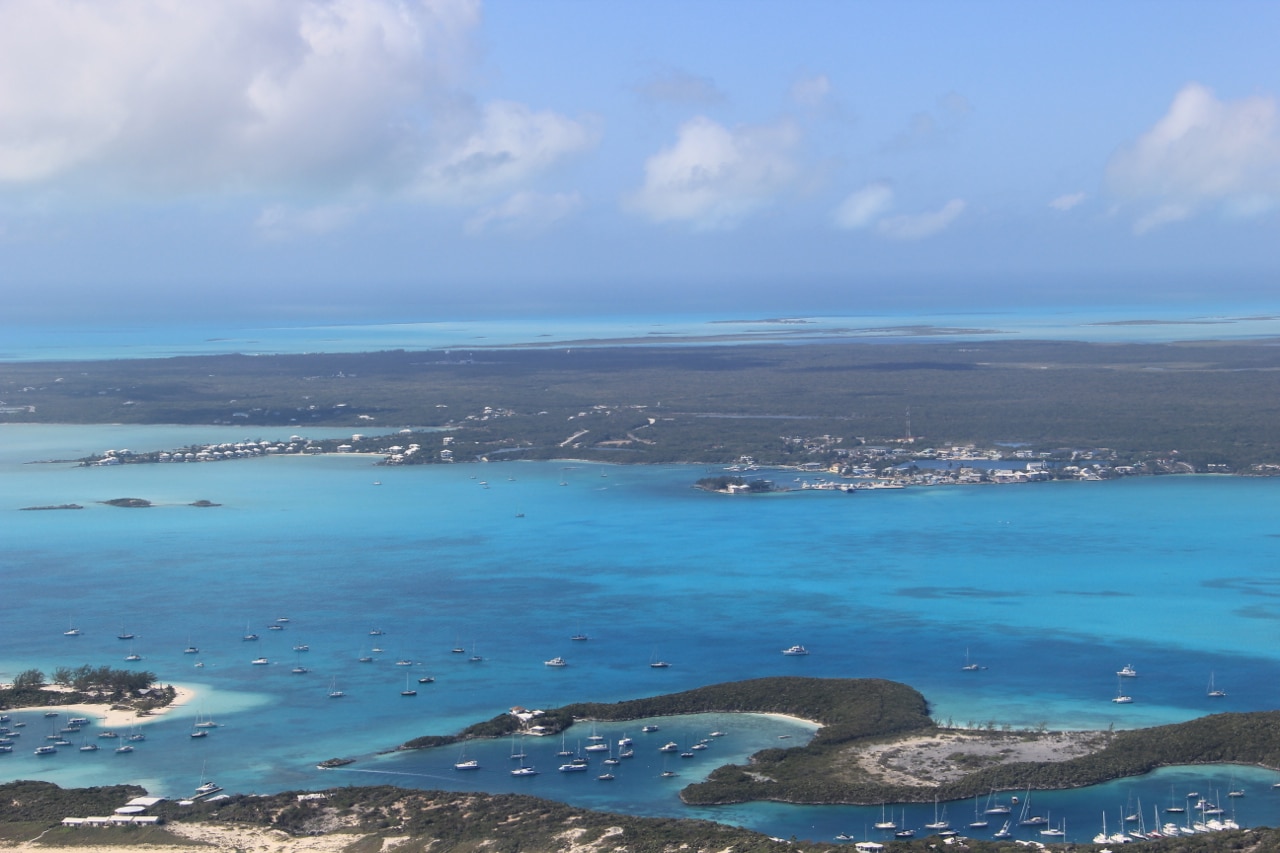Among the best areas to fly are the Bahamas and Caribean. Flying provides the best way to truly tour the islands and experience lesser known spots. Even after making dozens of trips to the islands over the years, each visit is a unique experience not to be missed.
This time, we travelled to the Bahamas with our friends John and Betty Obradovich, publishers of the Pilot’s Guide to the Bahamas and Caribbean, which is available in both book and iPad app form. John has been a Malibu recurrent training client of mine, and friend, for seven years. My wife Jane and I joined them on a trip to update the data in their guide.
We departed from Montgomery (KMYF) in their 1986 Piper Malibu.

Leaving in the late afternoon our first stop was at a friendly airport outside of El Paso, Horizon (T27). The next day we traveled to Apalachicola Florida (KAAF). We chose Apalachicola for an important reason, we had never been there! Apalachicola is a busy tourist destination so make sure you make lodging reservations if you decide to stay overnight. One hapless flying couple landed at night from Canada, assuming they could find lodging.
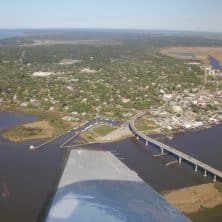
View of Apalachicola
The next morning our flight from Apalachicola to Fort Pierce (KFPR) was great, flying low across the Florida Panhandle with a great view of many more places we wanted to visit on another trip.
At Fort Pierce airport, we landed with a strong crosswind then taxied to the TIki Hut. The Tiki Hut is a visible landmark at KFPR where you can get food, fuel, and file your APIS and Flight plan. After filling up the plane, and ourselves it was off to Freeport for the first leg of our Bahama Island Tour! The Bahamas Government has a very easy process for entering their country by aircraft. You file out a Cruising Permit (multiple copies – it helps to bring carbon paper – yes carbon paper), and immigration forms for each passenger.
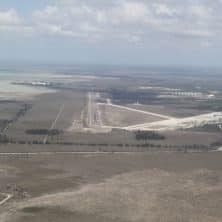
Freeport is a great first stop in the Bahamas. It is one of the larger cities in the Bahamas, on Grand Bahama Island. Each island has its own personality, with the larger cities offering more services that you would typically expect in the States. The ‘Out Islands’, offer a unique experience that is quite different than Grand Bahama or Providence (where Nassau is situated). We stayed at Port Lucaya in Freeport, with a great marina and marketplace which is frequented by tourists and locals.
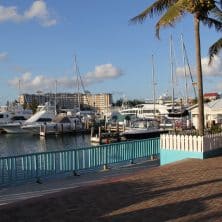
Freeport (MYGF) Grand Bahama to Marsh Harbour (MYAH), North Abaco
A great thing about flying the islands, is that there are over 60 airports in the Bahamas, and many are very close to restaurants for the proverbial $100 Grouper Sandwich! The islands vary in size from just a speck on the water to large land masses.
Extending east of Grand Bahama is a chain of islands called the Abacos. Departing from Freeport on a northeasterly heading we pointed the Malibu to Spanish Cay (pronounced ‘key’) in the north Abaco chain. Spanish Cay is one of the smallest private islands with an airport open to the public (Spanish Cay Airport).

Spanish Cay is the small island in the distance
Spanish Cay’s airport at one time was 5,000 feet long on an island not much bigger. Hurricane Sandy in 2012 did extensive damage to the island, including damaging one third of the runway. We didn’t have that information until we approached the island, which is one of the reasons we were flying to update the Pilot’s Guide. Google Maps was also outdated and still showed an intact runway. On my photo below you can see the damaged runway, with over 3,000 feet of available runway remaining.
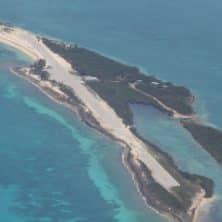
The damage from Hurricane Sandy is near the closest end of the runway
Landing on the narrow island, we parked next to a Piper Navajo and Chuck, who manages the resort and marina, picked us up for a short trip to the Marina. The Marina is in incredible condition, with an awesome restaurant. Perfect for the $100 Grouper Sandwich.
After a great lunch, Chuck took us back to the Malibu. John and I briefed the takeoff, with particular attention to a few obstacles on the departure end, in particular a crane.
After takeoff we headed for a tour of the outer Abacos on the way to Marsh Harbour (MYAH) on the main island of Abaco. The airport is in very good condition (http://goo.gl/maps/Um5YS) and it took only a few minutes to unload the airplane.
A taxi ride took us to the Lofty Fig (http://www.loftyfig.com/), a great inn with 6 comfortable villas. Sid is the owner of the Loft Fig which is in an excellent location directly across the street from one of Marsh Harbour’s finest marinas. If you visit ask Sid for his tips on the ring toss game!
Ring toss, BBQ at Lofty Fig.
The Abacos are definitely on a slower pace than Grand Bahama, which was perfect for us. A casual dinner overlooking the marina watching the sun set over the sea was a great end to the day.

Marsh Harbour Marina – Snappa’s Restaurant
The water was too choppy to rent a boat for a tour of the islands, so we took the ferry over to Elbo Key to visit Hope Town, one of the original settlements in the Abacos.
On Wednesday we headed on a leg to Georgetown on Great Exuma (MYEG). The Exumas is a chain of 360 islands, some of which are very small, many with airports (private and public).
Renting a car is a great way to tour the islands, even though it may be expensive compared to the States. A few miles north took us to Grand Isle, a condominium resort directly on the beach next to Sandals. The accommodations were great and only a short walk to the beach. The staff were attentive, and even helped entertain the kids of other guests. With masks and snorkels in hand, we entered the ocean for an opportunity to swim with the fish. We swam within a school of hundreds of fish within a few yards of the beach.
Georgetown Settlement
Georgetown is a great town to visit. Located south of the airport, it has a vibrant straw market and interesting stores to shop. In search of groceries for dinner, we met Patrick who was selling vegetables from his father’s garden. Jane and our son Rick are the farmers in our family, and it was great to exchange tips on growing vegetables with Patrick. One of the challenges in the Bahamas is self-sufficiency in food production. It was great to purchase the local produce for our dinner.

Purchasing vegetables from Patrick for the night’s dinner in Georgetown
We visited the Peace and Plenty Hotel, which is one of the oldest hotels on Exuma. Located on the water, with a ferry over to Stocking Island, it offered some of the best food on the island with an outstanding view.

View of Great Exuma
Andros Town – Andros
Departing from Georgetown we took the long route to Andros Town, initially proceeding south to view the settlement, then north along the western side of the Exuma chain. One of the best things about flying yourself in the Bahamas, is the view you get while flying between the islands. It is always a good idea to make detours to see the sights. The Exuma chain is no exception. Along the chain there are numerous airports, some of them publicly accessible. Runways range in length from 1000 feet (no typo!) to enough room for large jets. The runways can be rough since they are frequently made of local aggregate and infrequently maintained in some cases. This is usually not an issue for most general aviation aircraft.

There are several hundred islands in the Exuma Island chain
The Andros Town airport, also known as Fresh Creek (MYAF) is located on the eastern side of Andros Island. The runway was extended for use by the nearly US Navy’s underwater test center. The US Navy has reduced operations and upon landing we found the runway to be usable, but in rough condition. Andros is also known for having a large number of ‘Blue Holes’ on the island itself. These water holes extend down hundreds of feet and are popular for swimming, and diving. Adventurous divers will also explore the caves within the Blue Holes.

There is a great little store across from the terminal to get a drink and start relaxing, Andros style. We asked around for a car, and Anderson rented us his personal car for the day.
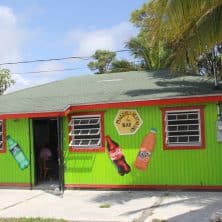
Maggies Restaurant at Andros Fresh Creek Airport (MYAF)
On the way to our accommodations, we stopped by Androsia. Androsia is famous for their batik fabric and clothing, having been established in the 70’s. You can find Androsia fabric all over the islands. In fact, if you see batik in Bahamas the chances are it is from this small factory on Andros.
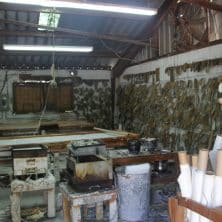
This is where they apply the stencils and wax for the Androsia Batik
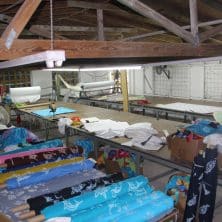
After the batik is completed, workers cut the fabric.
Small Hope Bay Lodge
We stayed at this lodge, in continuous operation since 1960 by the same family. This eco-friendly all inclusive lodge is incredible. Located north of Fresh Creek and adjacent to Davis Creek, guests enjoy scuba, fishing, eco-tours, and relaxing on a beach recently fortified by sand deposited by Hurricane Sandy. The same hurricane that ravaged some of the other islands, actually benefited this beach by the addition of wonderful sand. In honor of the storm they renamed their beach Sandy.
We were too late for diving, so Jane and I snorkeled in the warm water. We were surprised to see a number of large starfish scattered on the ocean floor. After swimming with a curious grouper and a number of fish, it was time for a cocktail by the beach. Rough life!
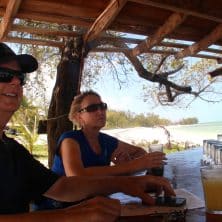
Relaxing at the Small Hope Bay Lodge bar after a strenuous day
Life is not always idyllic on the islands. There are numerous dangers that await the unsuspected person. Driving can be hazardous, especially when coconuts fall on the roads!
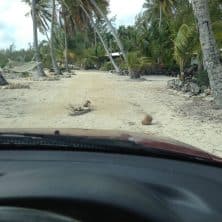
Dangerous driving conditions in the Bahamas. Watch out for falling coconuts!
Returning to the States
After filing our return International Flight Plan and ensuring that the APIS information was correct, we departed Fresh Creek for Fort Lauderdale Executive (FXE). It is an easy 1 hour flight in the Malibu. The most critical in flight issues to to ensure you open your Flight Plan (through Nassau, Miami Radio or Miami Center) and ensure you are in contact with Miami Center (IFR) or Miami Approach prior to crossing in to the Air Defense Identification Zone (ADIZ).
US Customs processing is very easy, just make sure you have all of your documentation completed, and with APIS it is much easier than the previous process of using the Arrival Reports.
